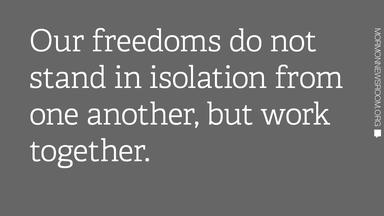“Congress shall make no law respecting an establishment of religion, or prohibiting the free exercise thereof; or abridging the freedom of speech, or of the press; or the right of the people peaceably to assemble, and to petition the government for a redress of grievances.” — The First Amendment of the Bill of Rights of the United States Constitution

On this day in 1791 the Bill of Rights of the United States Constitution was ratified. This action guaranteed freedoms not mentioned previously in the Constitution. The first provision lays the foundation for other rights. “Congress shall make no law respecting an establishment of religion, or prohibiting the free exercise thereof.” These two clauses offer double protection for religious freedom — they ensure the state cannot favor one religion over another, and they allow individuals and groups to live out their faith in public.
People call this the first freedom because it provides the basis on which the freedoms of speech, press, assembly and petition can flourish. The exercise of religion begins deep in the conscience. To assert that invisible space in the heart and soul of every individual where right and wrong are decided, where truth is wrestled and falsehood fought, is what makes us human beings. We find our mettle as we bring our conscience into society.
Our freedoms do not stand in isolation from one another, but work together. Scholars Brian Grim and Roger Finke write: “At the core of religious expression is the freedom of speech and at the core of freedom to worship is the freedom to assemble. To claim freedom of speech without allowing for a freedom to express religious beliefs quickly erodes freedom of speech in other areas. Likewise, allowing for restrictions on the assembly of religious groups opens the door for curtailing the activities of other groups as well. The denial of religious freedoms is inevitably intertwined with the denial of other freedoms.”[1]
The ratification of these rights resulted from the dilemma of how a society can function with clashing differences. Early America consisted of people of diverse races and religions who sought to live their lives and practice their faith without persecution. Though not always successful, the First Amendment established the framework to navigate these differences peaceably.

These rights do not exist to protect only those with whom we agree. They exist to protect the person whose opinions get in the way, whose thoughts and beliefs seem threatening and sound unpopular. Rights are not something to be enjoyed only by the majority sitting comfortably in power. They are also for the unseen minority, the forgotten and the voiceless. Rights protect the little guy, the big guy and all sizes in between. A premise of the First Amendment is that we can’t know for sure where truth, goodness or wisdom will come from. If diverse individuals and communities are allowed to believe and speak freely, then these virtues are bound to come through. As Joseph Smith said, “Truth will cut its own way.”[2]
America’s focus on religious freedom and other basic rights has experienced fits and starts but more or less held steady. A U.S. federal law says, “The right to freedom of religion undergirds the very origin and existence of the United States."[3] And President Barack Obama has described religious freedom as the “critical foundation of our Nation's liberty” and urged “every country to recognize religious freedom as both a universal right and a key to a stable, prosperous, and peaceful future.”[4]
That call to honor the freedom of the soul requires constant vigilance from the theist, atheist and agnostic. The 1948 Universal Declaration on Human Rights, adopted by the United Nations General Assembly, says “the inherent dignity” and “the equal and inalienable rights of all members of the human family” are the “foundation of freedom, justice and peace in the world.”[5] Yet today nearly 75 percent of the world’s population lives in countries with high or very high religious restrictions[6] and other rights violations.[7]
According to Latter-day Saint scripture, “governments were instituted of God for the benefit of man”[8] and should never “bind the consciences of men” or “suppress the freedom of the soul.”[9] Such space is sacred and transcends human authority. As John F. Kennedy said in an inaugural address 55 years ago, “the same revolutionary beliefs for which our forebears fought are still at issue around the globe — the belief that the rights of man come not from the generosity of the state, but from the hand of God.”[10]
It’s easy to take these freedoms for granted. After all, it is the ground many of us have walked on our entire lives. How often do we look down and appreciate that ground? Laws and rights inscribed on old parchments have little value if we don’t maintain them every day. Practicing our religion, speaking our minds, reading a newspaper, freely associating with fellow citizens and critiquing power are tender plants that require constant cultivation.
[1] Brian J. Grim and Roger Finke, The Price of Freedom Denied (2011), 205.
[2] History of the Church, 5:498–99; from a discourse given by Joseph Smith on July 9, 1843, in Nauvoo, Illinois; reported by Willard Richards.
[3] International Religious Freedom Act of 1998, 22 U.S.C. § 6401(a).
[4] Barack Obama, “Proclamation—Religious Freedom Day, 2014,” https://www.whitehouse.gov/the-press-office/2014/01/15/proclamation-religious-freedom-day-2014.
[5] Universal Declaration of Human Rights (adopted Dec. 10, 1948), UNGA Res 217 A(III) (UDHR) preamble.
[6] Pew Research Center, “Trends in Global Restrictions on Religion,” http://www.pewforum.org/2016/06/23/trends-in-global-restrictions-on-religion/.
[7] Human Rights Watch, World Report 2016, https://www.hrw.org/sites/default/files/world_report_download/wr2016_web.pdf.
[8] Doctrine and Covenants 134:1.
[9] Doctrine and Covenants 134:4.
[10] Inaugural Address of President John F. Kennedy, 1961, https://www.jfklibrary.org/Research/Research-Aids/Ready-Reference/JFK-Quotations/Inaugural-Address.aspx.